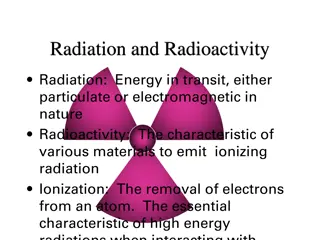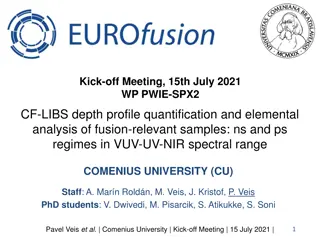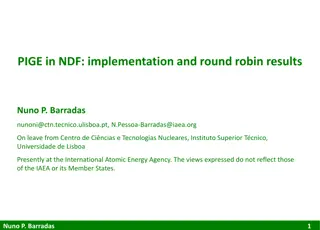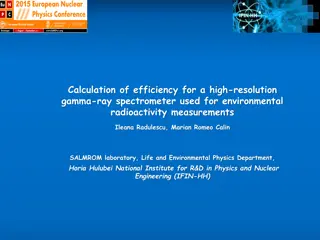Understanding Radioactive Decay and Nuclear Radiation
Radioactive decay is the process in which unstable atomic nuclei emit charged particles and energy, transforming into different elements. This process involves the emission of alpha particles, beta particles, and gamma rays. Alpha particles consist of two protons and two neutrons, beta particles are
4 views • 31 slides
Ensuring Safety and Quality- Gamma Radiation Sterilization for Diverse Applications
Ever wonder how bandages and medical tools stay germ-free? Gamma radiation sterilization eliminates bacteria & viruses using powerful rays! Learn how this safe and effective process ensures top quality in various industries. Visit Symec Engineers to explore its diverse applications
3 views • 3 slides
Systematic Analysis of Real Samples in Analytical Chemistry
This analysis covers the systematic process involved in analyzing real samples, including sampling, sample preservation, and sample preparation. It discusses the importance of accurate sampling in obtaining information about various substances, such as solids, liquids, gases, and biological material
0 views • 54 slides
Understanding Radioactivity and its Particles in Radiochemistry
Radioactivity involves the spontaneous decay of unstable atomic nuclei, releasing radiation in the form of alpha particles, beta particles, and gamma rays. Alpha particles are heavy and have low penetration, beta particles are light and faster, while gamma rays are high-energy waves with great penet
1 views • 20 slides
Spectrophotometric Determination of Cr and Mn in Steel Samples
This experiment aims to determine the concentrations of manganese and chromium in steel samples by converting Cr3+ and Mn2+ ions to light-absorbing forms, followed by spectrophotometric measurements at specific wavelengths. Steel samples are oxidized, dissolved, and further oxidized to form dichroma
0 views • 10 slides
Understanding Alpha, Beta, and Gamma Radiation: a Comparative Analysis
Explore the key differences between alpha, beta, and gamma radiation, their structures, penetration powers, absorption materials, ionizing abilities, and dangers. Learn about isotopes, radioactive decay, and the unique characteristics of each type of radiation. Dive into creating fact sheets and und
2 views • 7 slides
Understanding Radiation and Radioactivity in Science
Radiation is energy in transit, while radioactivity is the emission of ionizing radiation by materials. This process involves ionization, which removes electrons from atoms, leading to various nuclear decay processes such as alpha decay, beta decay, gamma-ray emission, positron decay, electron captu
0 views • 80 slides
Depth Profile Analysis of Fusion-Relevant Samples Using LIBS Technique
Analysis of fusion-relevant samples through Laser-Induced Breakdown Spectroscopy (LIBS) is conducted at Comenius University. The study compares picosecond (ps) and nanosecond (ns) regimes in depth profiling and quantification of tungsten-based coatings and other fusion materials. The research also i
0 views • 8 slides
Understanding Radioactivity and Nuclear Radiation
Radioactivity is the process in which unstable nuclei emit radiation, such as alpha, beta, or gamma particles, to become stable. This emission can change the element's identity and is crucial in fields like nuclear power and understanding Earth's core heat source. Different radioactive isotopes like
0 views • 12 slides
Introduction to Gamma Function and Equivalent Integral Forms
The Gamma function is a versatile mathematical function that generalizes the factorial function to non-integer and complex values. It has various integral definitions such as the Euler-integral form. The proof of the factorial property of the Gamma function is demonstrated through analytical continu
1 views • 20 slides
Understanding Soft Gamma-Ray Emissions from Pulsar Polar Caps
Soft gamma-ray emissions from the polar cap cascade region are a subject of interest in astrophysics, with studies focusing on the fundamental physical processes of pulsars and potential origins of non-thermal X-ray emissions. Researchers explore the emission processes, polar cap accelerators, casca
0 views • 16 slides
Accomplished Career in Nuclear Physics and Gamma-ray Spectroscopy
Experienced professional with a diverse background in nuclear physics and gamma-ray spectroscopy. Successfully held positions including Senior Gamma-ray Scientist, Professor, Associate Pro Vice Chancellor, and more. Achieved significant milestones such as securing research funding, supervising PhD s
1 views • 4 slides
Navigating Statistical Inference Challenges in Small Samples
In small samples, understanding the sampling distribution of estimators is crucial for valid inference, even when assumptions are violated. This involves careful consideration of normality assumptions, handling non-linear hypotheses, and computing standard errors for various statistics. As demonstra
0 views • 19 slides
Eta Sigma Gamma Zoom Initiation Guidelines
Hosting a remote initiation ceremony for Eta Sigma Gamma using Zoom is crucial during the pandemic. Follow the outlined steps for a seamless ceremony preparation and execution, ensuring the significance of the event is maintained. Key elements such as rough schedule, necessary materials, and new ini
1 views • 8 slides
Agglutination Testing in Laboratory Medicine
Agglutination testing is a common method used in laboratory medicine to detect the presence and amount of antigens or antibodies in patient samples. It involves the use of carrier particles such as latex, RBCs, charcoal, and protein A of Staph aureus. The testing process includes qualitative and qua
0 views • 18 slides
Understanding Gamma Knife Stereotactic Radiosurgery
The Gamma Knife Stereotactic Radiosurgery is a precise and effective treatment method where highly focused radiation beams are used to target tumors and abnormalities in the brain. It does not remove the tumor directly but affects DNA, cell growth, and blood vessels. The procedure involves three mai
0 views • 51 slides
Comprehensive Overview of TENORM Study Update in Pennsylvania
The TENORM Study Update in Pennsylvania focuses on the management of Technologically Enhanced Naturally Occurring Radioactive Material (TENORM) generated from natural gas exploration and production activities. The study addresses potential worker and public radiation exposure, environmental contamin
5 views • 16 slides
Exploring Cosmic Ray Sources Using Gamma-Ray Emission Data
This study focuses on investigating ultrahigh energy cosmic ray (UHECR) sources by analyzing extragalactic diffuse gamma-ray emission data. Techniques such as examining UHECR mass composition and arrival directions, as well as studying interactions with cosmic microwave and extragalactic background
0 views • 16 slides
Understanding the Location of Gamma-Ray Emission Zones in Blazars
This research explores the determination of the GeV emitting zone in fast, bright blazars through studies conducted during the AAS Meeting in January 2014. The focus is on locating the gamma-ray emission zone within blazars and investigating the critical differences between various energy scales lik
0 views • 23 slides
Overview of Observational Techniques and Student Talks in Astronomy
This content covers observational techniques, student talks, and dates related to various astronomical topics such as gamma-ray astronomy, basics of gamma-ray interaction, scintillators and solid-state detectors, Compton telescopes, and pair telescopes. It provides insights into the main processes i
0 views • 23 slides
Initiation Ceremony for New Eta Sigma Gamma Chapter Members
Witness the initiation ceremony into the Eta Sigma Gamma collegiate chapter, where new candidates are introduced and inducted with solemn rituals and historical significance. From the candle-lit entrance to the recitation of pledges, experience the traditions and values upheld by this esteemed profe
0 views • 27 slides
Study of Nuclear Fission Process Through Gamma-Ray Spectrometry
Delve into the nuclear fission process through prompt gamma-ray spectrometry, exploring motivations, experimental data, and preliminary results. Understand the gamma heating process in nuclear reactors and its significance in reactor safety. Contextualize the study within Generation III+ and IV reac
0 views • 86 slides
Insights from PADME ECal Meeting: Rejection Studies and BG Analysis
Explore the discussions and findings from the PADME ECal meeting on topics such as gamma rejection studies, toy MC studies of gamma background, ECAL geometrical definitions, BG studies, and detector acceptance. Key points include the proposal for a lead glass-based SAC and considerations on ineffici
0 views • 27 slides
Photoproduction of Pionic Atoms at the Gamma Factory: Research Overview
Research conducted by V. V. Flambaum, J. Jin, and D. Budker at the Gamma Factory (GF) on photoproduction of pionic atoms is detailed in this content. It explores the formation of pionic atoms with negative pions orbiting the nucleus in a hydrogen-like system, emphasizing strong interaction effects a
0 views • 11 slides
Principles and Implementation of PIGE in NDF by Nuno P. Barradas
Overview of the basic principles and implementation details of Particle Induced Gamma-ray Emission (PIGE) calculation using NDF code, including handling of stopping power, cross-sections, and sub-layers. The process involves simulating incident energy on each layer, calculating cross-sections, and i
0 views • 23 slides
Understanding Radiographic Testing: History, Science, and Radiation Safety
Exploring the history and science behind Radiographic Testing (RT), from the discovery of X-rays to the development of methods using gamma radiation. Learn about the terminology, natural radiation, and the characteristics of radiation in various forms. Understand the importance of safety measures in
0 views • 47 slides
Production Status and Solutions for Challenges in Particle Physics Experimentation
Addressing issues with event generation in particle physics experiments for W+jets and Z+jets, including solutions and recommendations for improving production efficiency and accuracy. Additionally, private discussions on gamma samples relevant for specific analyses are summarized, along with requir
0 views • 11 slides
Study on the Thermal and Chemical Properties of Polymer-Cement Composites
The study investigates the resistance of polymer-cement composites to thermal stress and chemical attacks such as acidic and high CO2 environments. Results show similar color changes in control cement and polymer-cement composites after thermal stress, with the latter maintaining compressive strengt
0 views • 5 slides
2016-2017 Greek Awards Ceremony Highlights
Highlighting the achievements of various chapters and individuals at the 2016-2017 Greek Awards ceremony held on March 9th, 2017. The event showcased outstanding chapter growth, scholarship attainment, community service initiatives, philanthropic endeavors, living ritual practices, sisterhood and br
0 views • 43 slides
Rho Gamma Application Process & Recruitment Information
Discover the application steps and timeline for becoming a Rho Gamma at Virginia Tech. Learn about the responsibilities, disassociation from your chapter, and the importance of empathy and selflessness in this impactful role. Additional information includes a required online course and post-recruitm
0 views • 6 slides
Advanced LIGO and Short Gamma-Ray Burst Search Overview
Advanced LIGO is focused on achieving a lower noise level and higher sensitivity to detect gravitational waves. The search involves analyzing data from the 1st Advanced LIGO Science Run, collaboration with Fermi, and seeking coincident detections of gravitational waves and gamma-ray bursts, particul
0 views • 13 slides
Insights into Gamma-Ray Burst Internal Plateaus
Gamma-ray burst (GRB) internal plateaus provide valuable insights into GRB prompt emission, afterglows, magnetars, and launch mechanisms. Long GRBs originate from massive star collapses, while short GRBs are associated with neutron star mergers. Understanding the properties of neutron stars and magn
0 views • 25 slides
Overview of CAIN Particle Tracking Code for High-Energy Colliders
CAIN is a particle tracking code used for high-energy collider simulations since 1984. Initially named ABEL, it evolved to include beam-laser interactions for gamma-gamma colliders. The code, written in FORTRAN 90, handles beam-beam and external fields, with a structure where all particles are store
0 views • 17 slides
Analytical Toxicology: Techniques and Sample Analysis in Clinical Toxicology
Analytical toxicology involves the observation, identification, and measurement of foreign compounds in biological and other samples, such as urine, blood, stomach contents, nails, hair, and DNA. Various techniques are used to isolate and identify drugs and poisons present in these samples. This fie
0 views • 12 slides
Efficiency Calculation of High-Resolution Gamma-Ray Spectrometer for Environmental Radioactivity Measurements
SALMROM laboratory at IFIN-HH conducts environmental radioactivity monitoring using high-resolution gamma-ray spectrometry. The system includes a Coaxial p-type HPGe detector with reliable traceability. Activities involve evaluating radon concentrations in various environments and assessing radionuc
0 views • 13 slides
Utilizing Different Samples for Diagnostic Testing in Medicine
The practice of diagnostic testing in medicine goes beyond blood and stool samples. Gathering urine samples, for example, allows healthcare providers to assess various health aspects, such as kidney function, urinary tract infections, diabetes, and more. By examining the color, clarity, odor, densit
0 views • 21 slides
Quality Assurance Sampling Protocols for Flower Lots under WAC 314-55-101
Quality assurance sampling protocols for flower lots under WAC 314-55-101 dictate that at least 4g of flower lot samples are required, with procedures outlining the deduction of four separate samples from different quadrants of the lot to ensure representativeness. The WSLCB Traceability system enfo
0 views • 4 slides
Solving Cosmic Gamma Background Anomaly: Ekaterina Shlepkina's Research Insights
Explore the quest to find a solution for the cosmic gamma background anomaly in cosmic rays through Ekaterina Shlepkina's research presented at the XXII International Workshop. Learn about the investigations into cosmic rays fluxes, antiparticle studies, and possible interaction types of Dark Matter
1 views • 19 slides
Overview of GAMMA-400 Scientific Complex
The GAMMA-400 Scientific Complex, designed by experts from National Research Nuclear University MEPhI and other institutions, consists of a gamma-ray telescope, space observatory, and various detectors for studying cosmic gamma emission, electron/positron fluxes, and cosmic-ray nuclei fluxes. The co
0 views • 16 slides
Ensuring Chain of Evidence Integrity in Cargo Sampling
The chain of evidence is crucial in cargo sampling to establish a direct link between declared cargo, samples taken, and analyst's findings. This involves physical measures like identification of goods and representative samples, as well as documentary measures such as examination accounts and labor
0 views • 13 slides






































